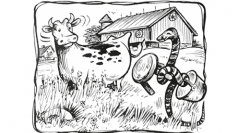

 Anthropozoologica
52 (1) - Pages 59-81
Anthropozoologica
52 (1) - Pages 59-81Cross-cultural folk beliefs about milk-suckling or milk-drinking amphibians and reptiles have long been noted by scholars. European dialectal folklore, for instance, has countless instances of cow-suckling and milk-stealing animals including butterflies, reptiles, batrachians, hares, hedgehogs and nocturnal birds. These creatures are regularly said to sneak into the domestic space at night to suck life-giving milk or blood from cattle and women. The early documentary evidence for this set of ideas, which relies, in great part, on the motif of breasts or udders suckled by a snake or similar animals such as toads or lizards, has not yet received the study it so richly deserves. Ideally, a comparative study of the milk-suckling reptile (both animal-human and animal-animal) would be carried out across the full gamut of relevant disciplines including ethnology, linguistics, philology, folklore and historical-religious studies: this would naturally include pre-modern written references and an analysis of their transmission. This paper aims to open up new avenues for research on the traditional fondness of snakes for milk, a truly ‘impossible biology’. It is built around several known and little known pre-modern literary and iconographic sources – examples can be found from much of Eurasia – and adopts an interdisciplinary and retrospective comparative method.
Snake-lore, milk-drinking reptile, milk-suckling snake, bosom serpent, pre-modern folklore